Detailed Report on Principles of Administration and Office Management
VerifiedAdded on 2020/07/23
|13
|2958
|116
Report
AI Summary
This report on the principles of administration covers various aspects of office management and business operations. It begins with legal requirements related to office facilities, typical services provided, and the establishment of office management procedures. The report further explores managing office resources, monitoring work flows, and providing support and welfare facilities for office workers. It then delves into health and safety obligations, accident and emergency procedures, and the importance of meeting minutes, including legal implications and accuracy. The report also examines different types of meetings, the roles of participants, and facilitation techniques. Furthermore, it discusses the use of targets and budgets for workload management, quality management techniques, and event planning. The conclusion summarizes the key takeaways and importance of effective administration in a business setting.

PRINCIPLES OF
ADMINISTRATION
ADMINISTRATION
Paraphrase This Document
Need a fresh take? Get an instant paraphrase of this document with our AI Paraphraser
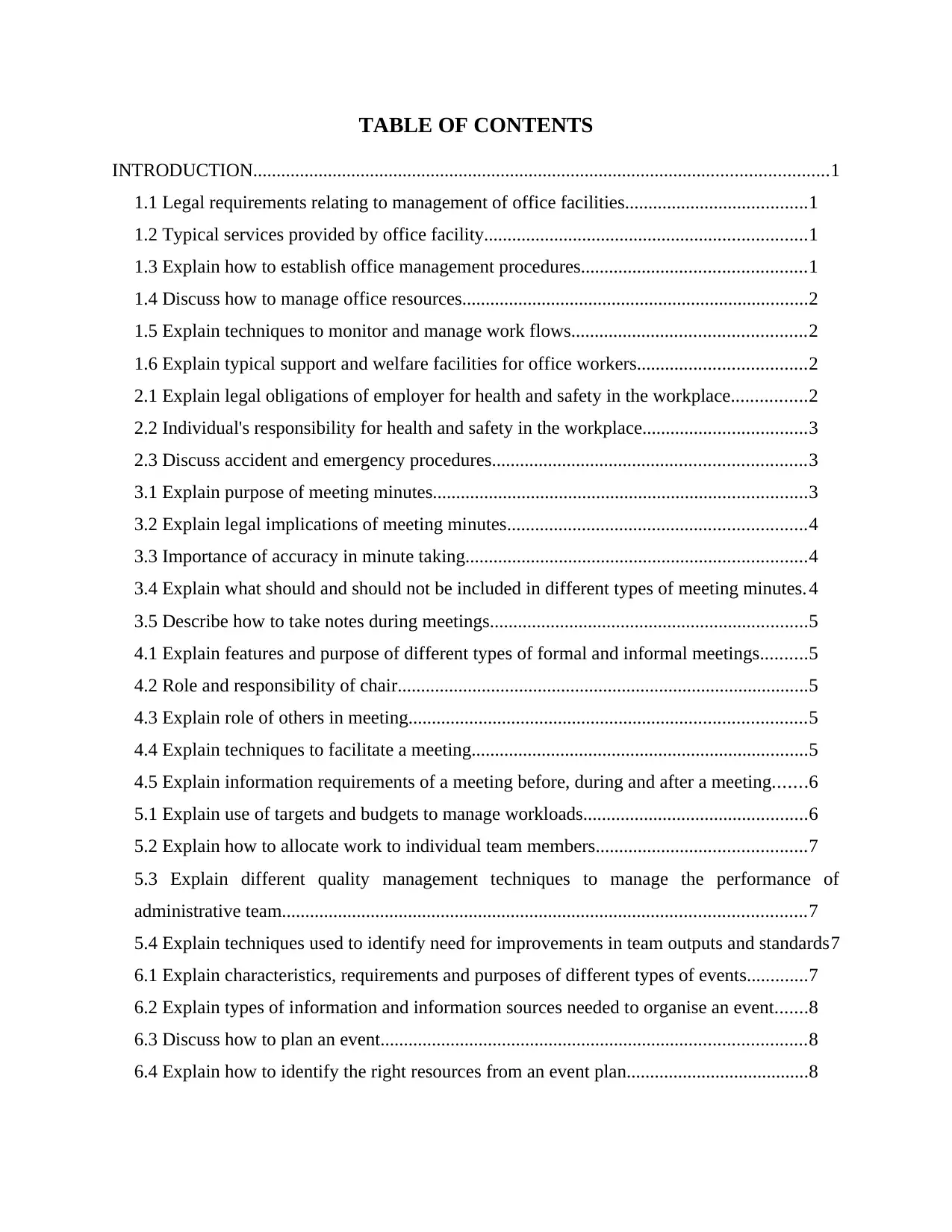
TABLE OF CONTENTS
INTRODUCTION...........................................................................................................................1
1.1 Legal requirements relating to management of office facilities.......................................1
1.2 Typical services provided by office facility.....................................................................1
1.3 Explain how to establish office management procedures................................................1
1.4 Discuss how to manage office resources..........................................................................2
1.5 Explain techniques to monitor and manage work flows..................................................2
1.6 Explain typical support and welfare facilities for office workers....................................2
2.1 Explain legal obligations of employer for health and safety in the workplace................2
2.2 Individual's responsibility for health and safety in the workplace...................................3
2.3 Discuss accident and emergency procedures...................................................................3
3.1 Explain purpose of meeting minutes................................................................................3
3.2 Explain legal implications of meeting minutes................................................................4
3.3 Importance of accuracy in minute taking.........................................................................4
3.4 Explain what should and should not be included in different types of meeting minutes. 4
3.5 Describe how to take notes during meetings....................................................................5
4.1 Explain features and purpose of different types of formal and informal meetings..........5
4.2 Role and responsibility of chair........................................................................................5
4.3 Explain role of others in meeting.....................................................................................5
4.4 Explain techniques to facilitate a meeting........................................................................5
4.5 Explain information requirements of a meeting before, during and after a meeting.......6
5.1 Explain use of targets and budgets to manage workloads................................................6
5.2 Explain how to allocate work to individual team members.............................................7
5.3 Explain different quality management techniques to manage the performance of
administrative team................................................................................................................7
5.4 Explain techniques used to identify need for improvements in team outputs and standards7
6.1 Explain characteristics, requirements and purposes of different types of events.............7
6.2 Explain types of information and information sources needed to organise an event.......8
6.3 Discuss how to plan an event...........................................................................................8
6.4 Explain how to identify the right resources from an event plan.......................................8
INTRODUCTION...........................................................................................................................1
1.1 Legal requirements relating to management of office facilities.......................................1
1.2 Typical services provided by office facility.....................................................................1
1.3 Explain how to establish office management procedures................................................1
1.4 Discuss how to manage office resources..........................................................................2
1.5 Explain techniques to monitor and manage work flows..................................................2
1.6 Explain typical support and welfare facilities for office workers....................................2
2.1 Explain legal obligations of employer for health and safety in the workplace................2
2.2 Individual's responsibility for health and safety in the workplace...................................3
2.3 Discuss accident and emergency procedures...................................................................3
3.1 Explain purpose of meeting minutes................................................................................3
3.2 Explain legal implications of meeting minutes................................................................4
3.3 Importance of accuracy in minute taking.........................................................................4
3.4 Explain what should and should not be included in different types of meeting minutes. 4
3.5 Describe how to take notes during meetings....................................................................5
4.1 Explain features and purpose of different types of formal and informal meetings..........5
4.2 Role and responsibility of chair........................................................................................5
4.3 Explain role of others in meeting.....................................................................................5
4.4 Explain techniques to facilitate a meeting........................................................................5
4.5 Explain information requirements of a meeting before, during and after a meeting.......6
5.1 Explain use of targets and budgets to manage workloads................................................6
5.2 Explain how to allocate work to individual team members.............................................7
5.3 Explain different quality management techniques to manage the performance of
administrative team................................................................................................................7
5.4 Explain techniques used to identify need for improvements in team outputs and standards7
6.1 Explain characteristics, requirements and purposes of different types of events.............7
6.2 Explain types of information and information sources needed to organise an event.......8
6.3 Discuss how to plan an event...........................................................................................8
6.4 Explain how to identify the right resources from an event plan.......................................8
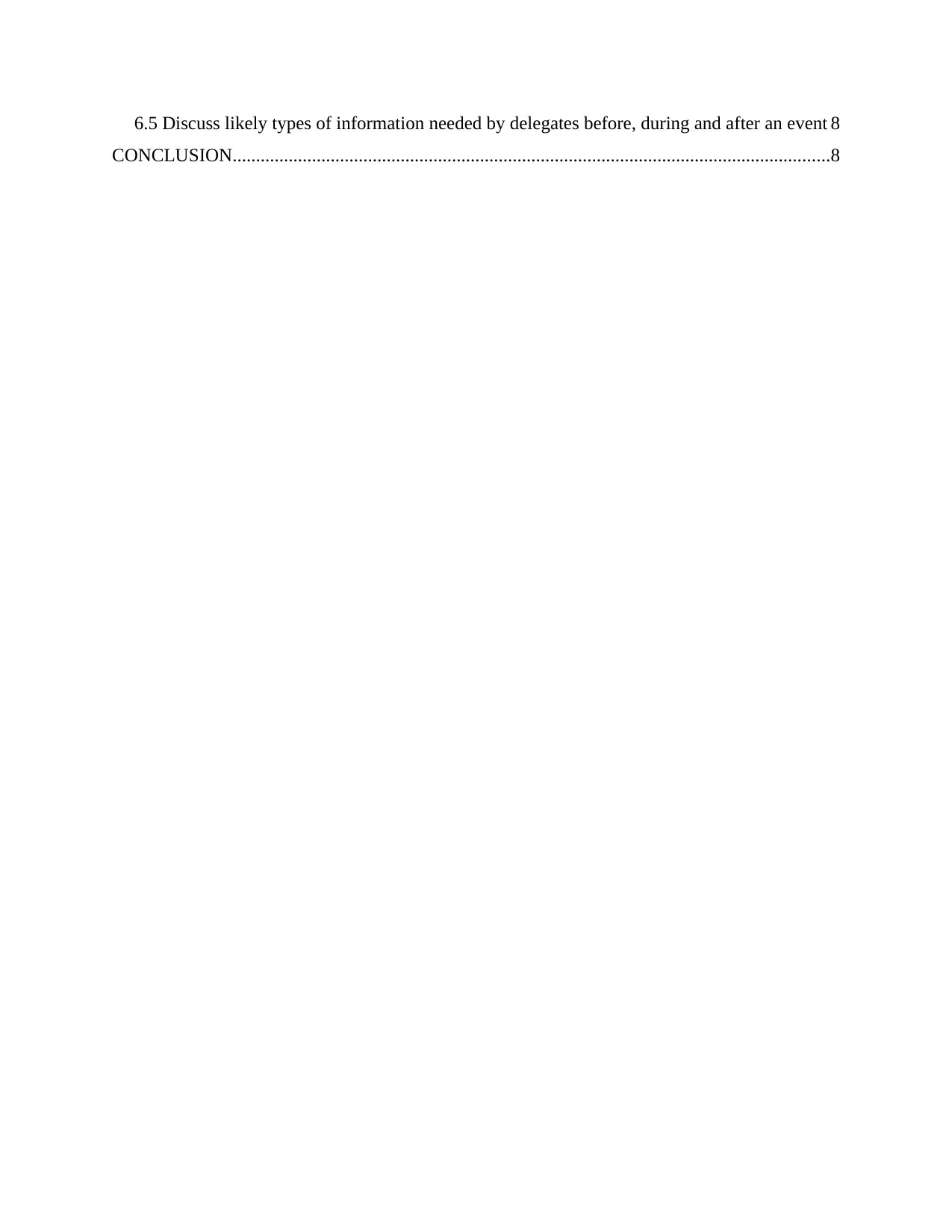
6.5 Discuss likely types of information needed by delegates before, during and after an event 8
CONCLUSION................................................................................................................................8
CONCLUSION................................................................................................................................8
⊘ This is a preview!⊘
Do you want full access?
Subscribe today to unlock all pages.

Trusted by 1+ million students worldwide
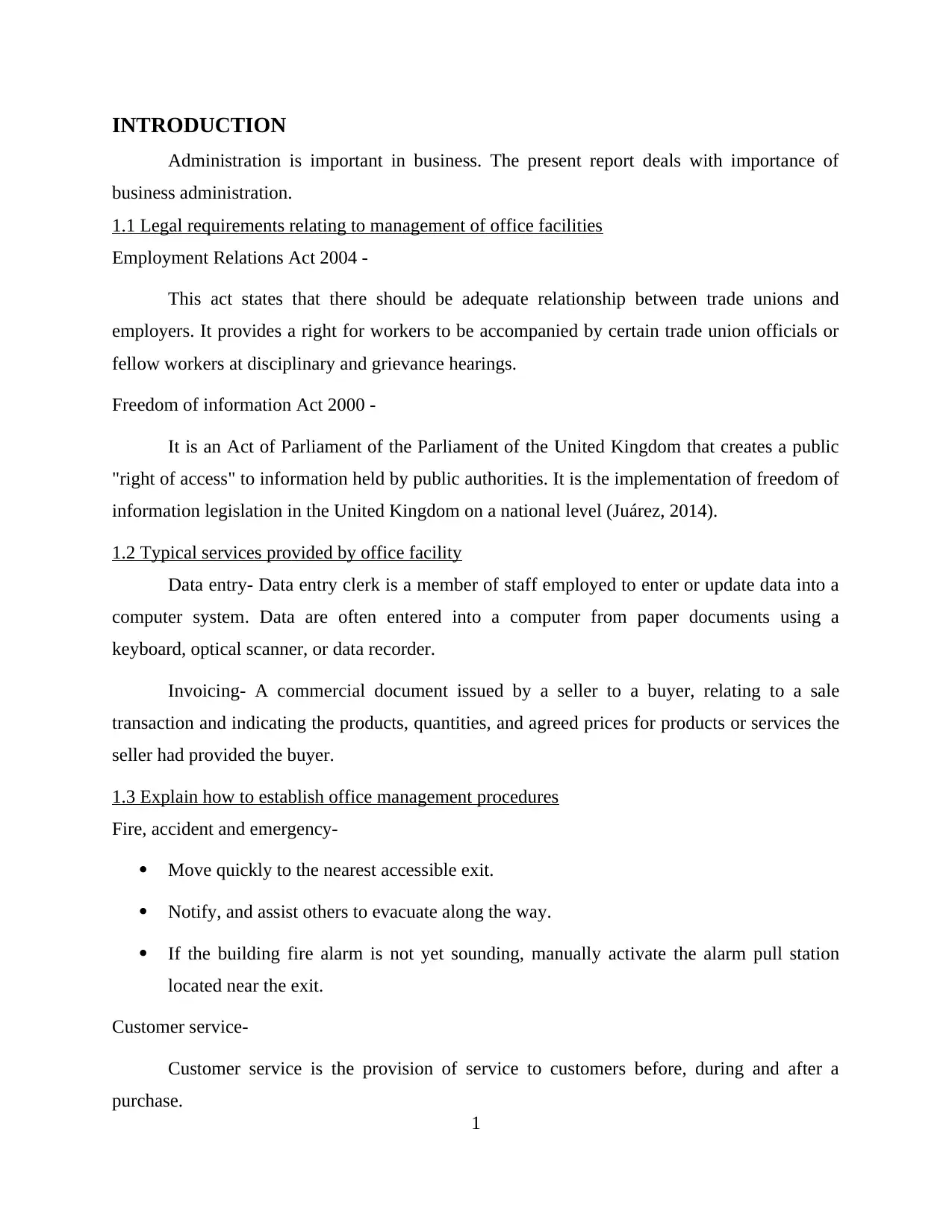
INTRODUCTION
Administration is important in business. The present report deals with importance of
business administration.
1.1 Legal requirements relating to management of office facilities
Employment Relations Act 2004 -
This act states that there should be adequate relationship between trade unions and
employers. It provides a right for workers to be accompanied by certain trade union officials or
fellow workers at disciplinary and grievance hearings.
Freedom of information Act 2000 -
It is an Act of Parliament of the Parliament of the United Kingdom that creates a public
"right of access" to information held by public authorities. It is the implementation of freedom of
information legislation in the United Kingdom on a national level (Juárez, 2014).
1.2 Typical services provided by office facility
Data entry- Data entry clerk is a member of staff employed to enter or update data into a
computer system. Data are often entered into a computer from paper documents using a
keyboard, optical scanner, or data recorder.
Invoicing- A commercial document issued by a seller to a buyer, relating to a sale
transaction and indicating the products, quantities, and agreed prices for products or services the
seller had provided the buyer.
1.3 Explain how to establish office management procedures
Fire, accident and emergency-
Move quickly to the nearest accessible exit.
Notify, and assist others to evacuate along the way.
If the building fire alarm is not yet sounding, manually activate the alarm pull station
located near the exit.
Customer service-
Customer service is the provision of service to customers before, during and after a
purchase.
1
Administration is important in business. The present report deals with importance of
business administration.
1.1 Legal requirements relating to management of office facilities
Employment Relations Act 2004 -
This act states that there should be adequate relationship between trade unions and
employers. It provides a right for workers to be accompanied by certain trade union officials or
fellow workers at disciplinary and grievance hearings.
Freedom of information Act 2000 -
It is an Act of Parliament of the Parliament of the United Kingdom that creates a public
"right of access" to information held by public authorities. It is the implementation of freedom of
information legislation in the United Kingdom on a national level (Juárez, 2014).
1.2 Typical services provided by office facility
Data entry- Data entry clerk is a member of staff employed to enter or update data into a
computer system. Data are often entered into a computer from paper documents using a
keyboard, optical scanner, or data recorder.
Invoicing- A commercial document issued by a seller to a buyer, relating to a sale
transaction and indicating the products, quantities, and agreed prices for products or services the
seller had provided the buyer.
1.3 Explain how to establish office management procedures
Fire, accident and emergency-
Move quickly to the nearest accessible exit.
Notify, and assist others to evacuate along the way.
If the building fire alarm is not yet sounding, manually activate the alarm pull station
located near the exit.
Customer service-
Customer service is the provision of service to customers before, during and after a
purchase.
1
Paraphrase This Document
Need a fresh take? Get an instant paraphrase of this document with our AI Paraphraser
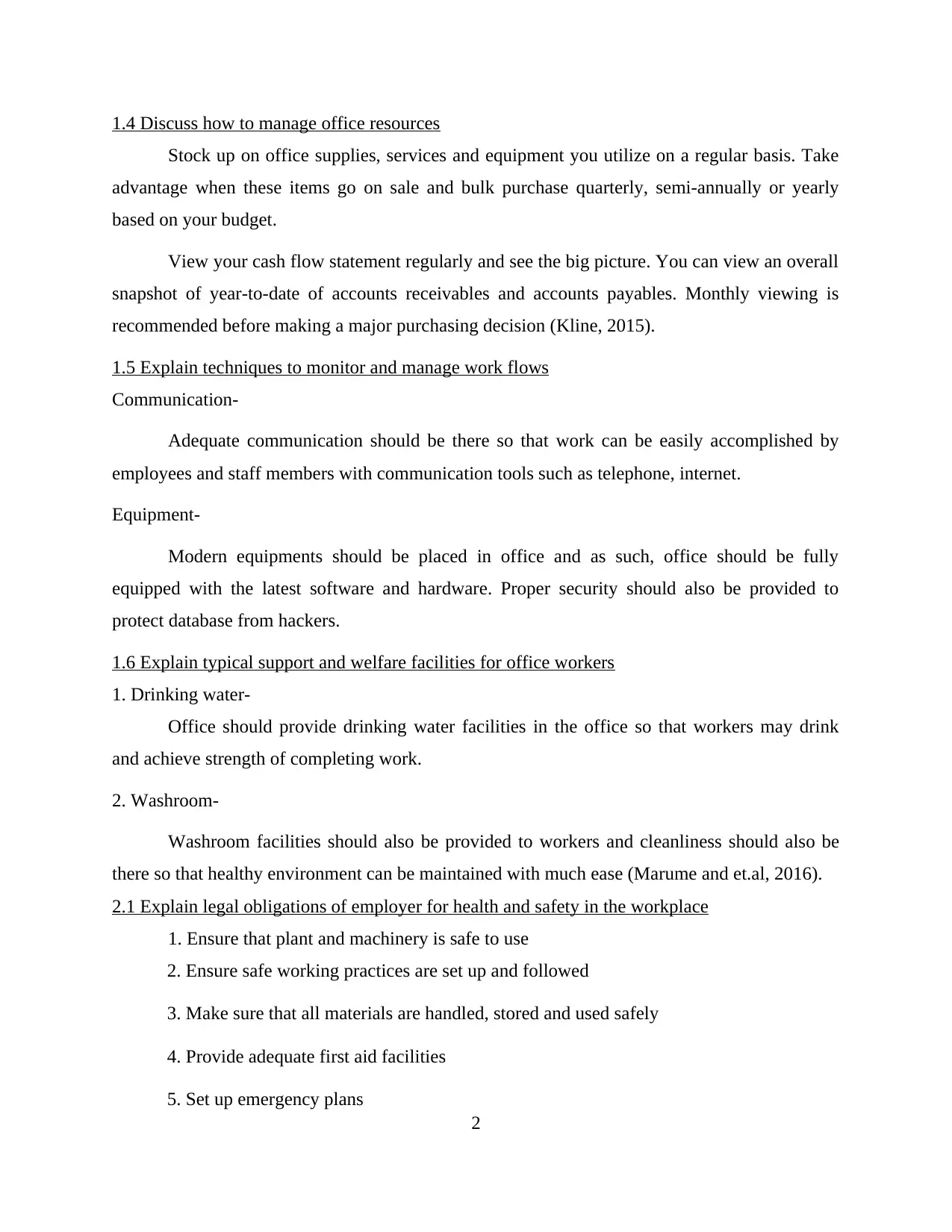
1.4 Discuss how to manage office resources
Stock up on office supplies, services and equipment you utilize on a regular basis. Take
advantage when these items go on sale and bulk purchase quarterly, semi-annually or yearly
based on your budget.
View your cash flow statement regularly and see the big picture. You can view an overall
snapshot of year-to-date of accounts receivables and accounts payables. Monthly viewing is
recommended before making a major purchasing decision (Kline, 2015).
1.5 Explain techniques to monitor and manage work flows
Communication-
Adequate communication should be there so that work can be easily accomplished by
employees and staff members with communication tools such as telephone, internet.
Equipment-
Modern equipments should be placed in office and as such, office should be fully
equipped with the latest software and hardware. Proper security should also be provided to
protect database from hackers.
1.6 Explain typical support and welfare facilities for office workers
1. Drinking water-
Office should provide drinking water facilities in the office so that workers may drink
and achieve strength of completing work.
2. Washroom-
Washroom facilities should also be provided to workers and cleanliness should also be
there so that healthy environment can be maintained with much ease (Marume and et.al, 2016).
2.1 Explain legal obligations of employer for health and safety in the workplace
1. Ensure that plant and machinery is safe to use
2. Ensure safe working practices are set up and followed
3. Make sure that all materials are handled, stored and used safely
4. Provide adequate first aid facilities
5. Set up emergency plans
2
Stock up on office supplies, services and equipment you utilize on a regular basis. Take
advantage when these items go on sale and bulk purchase quarterly, semi-annually or yearly
based on your budget.
View your cash flow statement regularly and see the big picture. You can view an overall
snapshot of year-to-date of accounts receivables and accounts payables. Monthly viewing is
recommended before making a major purchasing decision (Kline, 2015).
1.5 Explain techniques to monitor and manage work flows
Communication-
Adequate communication should be there so that work can be easily accomplished by
employees and staff members with communication tools such as telephone, internet.
Equipment-
Modern equipments should be placed in office and as such, office should be fully
equipped with the latest software and hardware. Proper security should also be provided to
protect database from hackers.
1.6 Explain typical support and welfare facilities for office workers
1. Drinking water-
Office should provide drinking water facilities in the office so that workers may drink
and achieve strength of completing work.
2. Washroom-
Washroom facilities should also be provided to workers and cleanliness should also be
there so that healthy environment can be maintained with much ease (Marume and et.al, 2016).
2.1 Explain legal obligations of employer for health and safety in the workplace
1. Ensure that plant and machinery is safe to use
2. Ensure safe working practices are set up and followed
3. Make sure that all materials are handled, stored and used safely
4. Provide adequate first aid facilities
5. Set up emergency plans
2
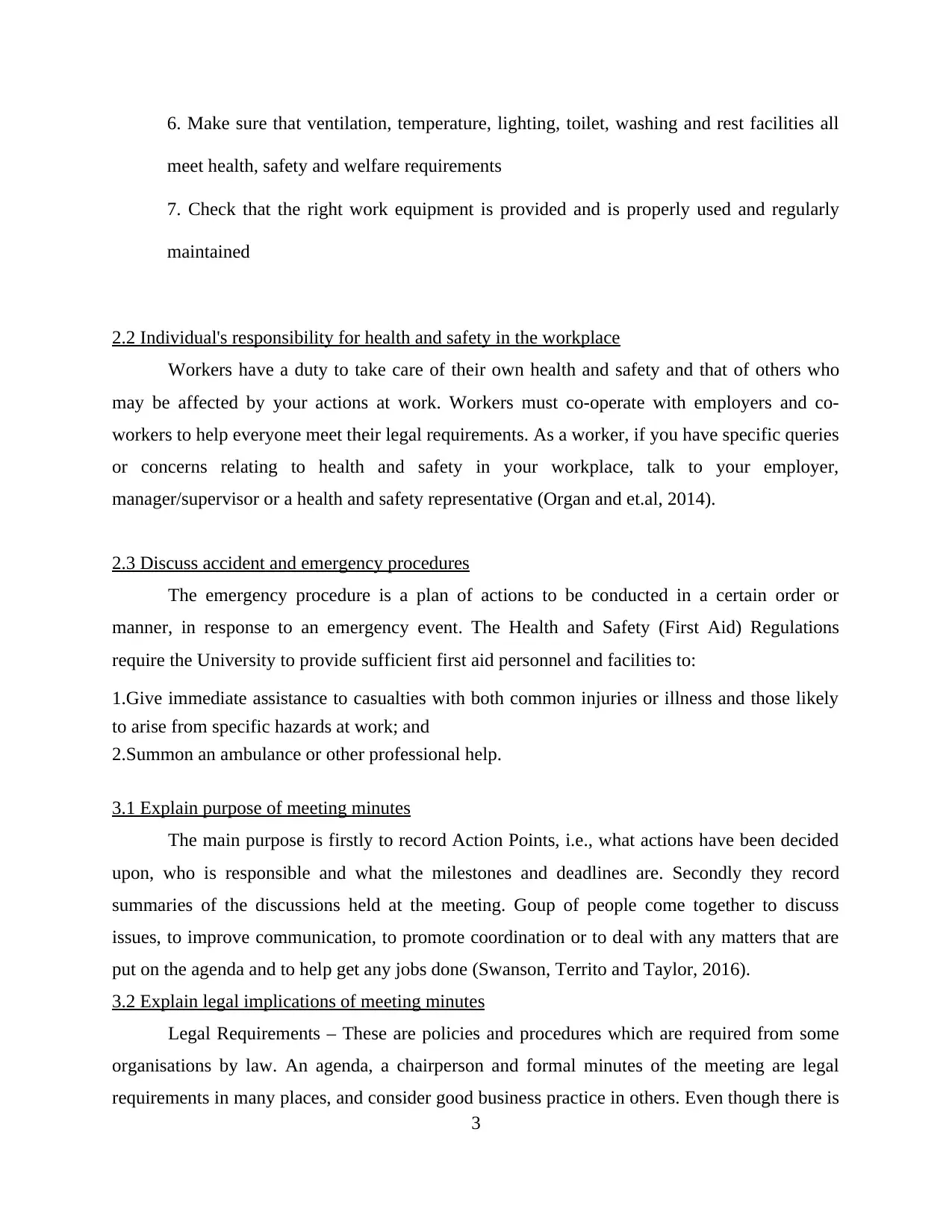
6. Make sure that ventilation, temperature, lighting, toilet, washing and rest facilities all
meet health, safety and welfare requirements
7. Check that the right work equipment is provided and is properly used and regularly
maintained
2.2 Individual's responsibility for health and safety in the workplace
Workers have a duty to take care of their own health and safety and that of others who
may be affected by your actions at work. Workers must co-operate with employers and co-
workers to help everyone meet their legal requirements. As a worker, if you have specific queries
or concerns relating to health and safety in your workplace, talk to your employer,
manager/supervisor or a health and safety representative (Organ and et.al, 2014).
2.3 Discuss accident and emergency procedures
The emergency procedure is a plan of actions to be conducted in a certain order or
manner, in response to an emergency event. The Health and Safety (First Aid) Regulations
require the University to provide sufficient first aid personnel and facilities to:
1.Give immediate assistance to casualties with both common injuries or illness and those likely
to arise from specific hazards at work; and
2.Summon an ambulance or other professional help.
3.1 Explain purpose of meeting minutes
The main purpose is firstly to record Action Points, i.e., what actions have been decided
upon, who is responsible and what the milestones and deadlines are. Secondly they record
summaries of the discussions held at the meeting. Goup of people come together to discuss
issues, to improve communication, to promote coordination or to deal with any matters that are
put on the agenda and to help get any jobs done (Swanson, Territo and Taylor, 2016).
3.2 Explain legal implications of meeting minutes
Legal Requirements – These are policies and procedures which are required from some
organisations by law. An agenda, a chairperson and formal minutes of the meeting are legal
requirements in many places, and consider good business practice in others. Even though there is
3
meet health, safety and welfare requirements
7. Check that the right work equipment is provided and is properly used and regularly
maintained
2.2 Individual's responsibility for health and safety in the workplace
Workers have a duty to take care of their own health and safety and that of others who
may be affected by your actions at work. Workers must co-operate with employers and co-
workers to help everyone meet their legal requirements. As a worker, if you have specific queries
or concerns relating to health and safety in your workplace, talk to your employer,
manager/supervisor or a health and safety representative (Organ and et.al, 2014).
2.3 Discuss accident and emergency procedures
The emergency procedure is a plan of actions to be conducted in a certain order or
manner, in response to an emergency event. The Health and Safety (First Aid) Regulations
require the University to provide sufficient first aid personnel and facilities to:
1.Give immediate assistance to casualties with both common injuries or illness and those likely
to arise from specific hazards at work; and
2.Summon an ambulance or other professional help.
3.1 Explain purpose of meeting minutes
The main purpose is firstly to record Action Points, i.e., what actions have been decided
upon, who is responsible and what the milestones and deadlines are. Secondly they record
summaries of the discussions held at the meeting. Goup of people come together to discuss
issues, to improve communication, to promote coordination or to deal with any matters that are
put on the agenda and to help get any jobs done (Swanson, Territo and Taylor, 2016).
3.2 Explain legal implications of meeting minutes
Legal Requirements – These are policies and procedures which are required from some
organisations by law. An agenda, a chairperson and formal minutes of the meeting are legal
requirements in many places, and consider good business practice in others. Even though there is
3
⊘ This is a preview!⊘
Do you want full access?
Subscribe today to unlock all pages.

Trusted by 1+ million students worldwide
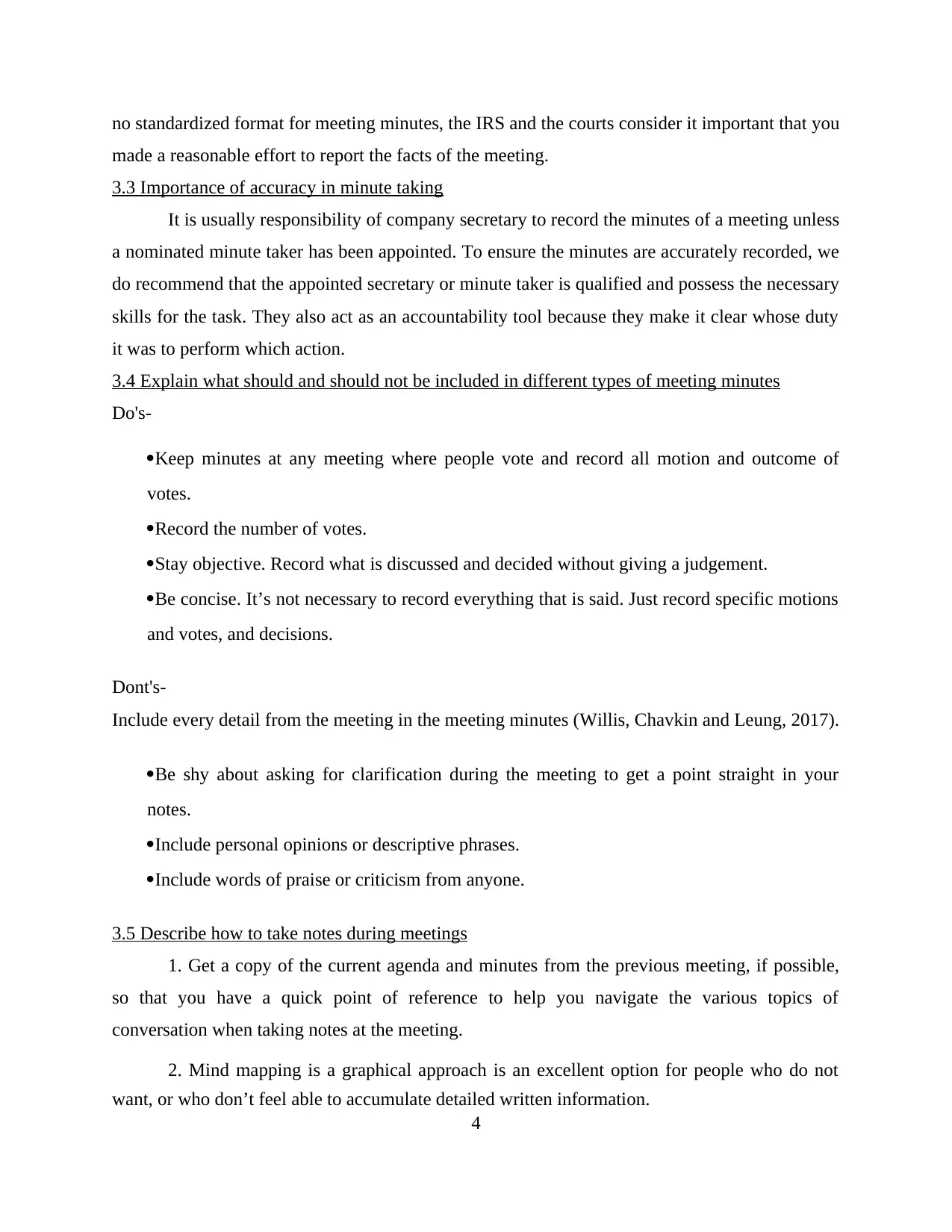
no standardized format for meeting minutes, the IRS and the courts consider it important that you
made a reasonable effort to report the facts of the meeting.
3.3 Importance of accuracy in minute taking
It is usually responsibility of company secretary to record the minutes of a meeting unless
a nominated minute taker has been appointed. To ensure the minutes are accurately recorded, we
do recommend that the appointed secretary or minute taker is qualified and possess the necessary
skills for the task. They also act as an accountability tool because they make it clear whose duty
it was to perform which action.
3.4 Explain what should and should not be included in different types of meeting minutes
Do's-
Keep minutes at any meeting where people vote and record all motion and outcome of
votes.
Record the number of votes.
Stay objective. Record what is discussed and decided without giving a judgement.
Be concise. It’s not necessary to record everything that is said. Just record specific motions
and votes, and decisions.
Dont's-
Include every detail from the meeting in the meeting minutes (Willis, Chavkin and Leung, 2017).
Be shy about asking for clarification during the meeting to get a point straight in your
notes.
Include personal opinions or descriptive phrases.
Include words of praise or criticism from anyone.
3.5 Describe how to take notes during meetings
1. Get a copy of the current agenda and minutes from the previous meeting, if possible,
so that you have a quick point of reference to help you navigate the various topics of
conversation when taking notes at the meeting.
2. Mind mapping is a graphical approach is an excellent option for people who do not
want, or who don’t feel able to accumulate detailed written information.
4
made a reasonable effort to report the facts of the meeting.
3.3 Importance of accuracy in minute taking
It is usually responsibility of company secretary to record the minutes of a meeting unless
a nominated minute taker has been appointed. To ensure the minutes are accurately recorded, we
do recommend that the appointed secretary or minute taker is qualified and possess the necessary
skills for the task. They also act as an accountability tool because they make it clear whose duty
it was to perform which action.
3.4 Explain what should and should not be included in different types of meeting minutes
Do's-
Keep minutes at any meeting where people vote and record all motion and outcome of
votes.
Record the number of votes.
Stay objective. Record what is discussed and decided without giving a judgement.
Be concise. It’s not necessary to record everything that is said. Just record specific motions
and votes, and decisions.
Dont's-
Include every detail from the meeting in the meeting minutes (Willis, Chavkin and Leung, 2017).
Be shy about asking for clarification during the meeting to get a point straight in your
notes.
Include personal opinions or descriptive phrases.
Include words of praise or criticism from anyone.
3.5 Describe how to take notes during meetings
1. Get a copy of the current agenda and minutes from the previous meeting, if possible,
so that you have a quick point of reference to help you navigate the various topics of
conversation when taking notes at the meeting.
2. Mind mapping is a graphical approach is an excellent option for people who do not
want, or who don’t feel able to accumulate detailed written information.
4
Paraphrase This Document
Need a fresh take? Get an instant paraphrase of this document with our AI Paraphraser
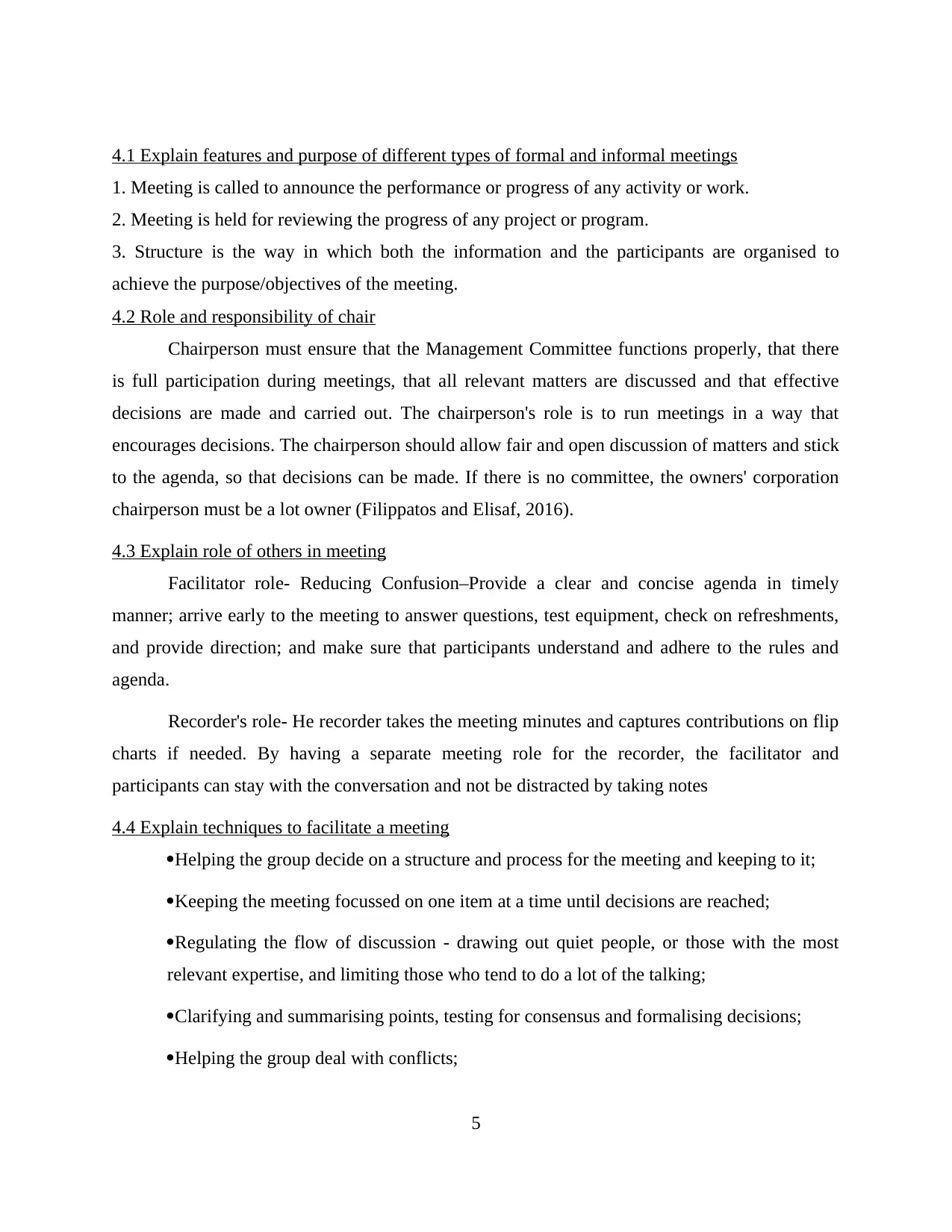
4.1 Explain features and purpose of different types of formal and informal meetings
1. Meeting is called to announce the performance or progress of any activity or work.
2. Meeting is held for reviewing the progress of any project or program.
3. Structure is the way in which both the information and the participants are organised to
achieve the purpose/objectives of the meeting.
4.2 Role and responsibility of chair
Chairperson must ensure that the Management Committee functions properly, that there
is full participation during meetings, that all relevant matters are discussed and that effective
decisions are made and carried out. The chairperson's role is to run meetings in a way that
encourages decisions. The chairperson should allow fair and open discussion of matters and stick
to the agenda, so that decisions can be made. If there is no committee, the owners' corporation
chairperson must be a lot owner (Filippatos and Elisaf, 2016).
4.3 Explain role of others in meeting
Facilitator role- Reducing Confusion–Provide a clear and concise agenda in timely
manner; arrive early to the meeting to answer questions, test equipment, check on refreshments,
and provide direction; and make sure that participants understand and adhere to the rules and
agenda.
Recorder's role- He recorder takes the meeting minutes and captures contributions on flip
charts if needed. By having a separate meeting role for the recorder, the facilitator and
participants can stay with the conversation and not be distracted by taking notes
4.4 Explain techniques to facilitate a meeting
Helping the group decide on a structure and process for the meeting and keeping to it;
Keeping the meeting focussed on one item at a time until decisions are reached;
Regulating the flow of discussion - drawing out quiet people, or those with the most
relevant expertise, and limiting those who tend to do a lot of the talking;
Clarifying and summarising points, testing for consensus and formalising decisions;
Helping the group deal with conflicts;
5
1. Meeting is called to announce the performance or progress of any activity or work.
2. Meeting is held for reviewing the progress of any project or program.
3. Structure is the way in which both the information and the participants are organised to
achieve the purpose/objectives of the meeting.
4.2 Role and responsibility of chair
Chairperson must ensure that the Management Committee functions properly, that there
is full participation during meetings, that all relevant matters are discussed and that effective
decisions are made and carried out. The chairperson's role is to run meetings in a way that
encourages decisions. The chairperson should allow fair and open discussion of matters and stick
to the agenda, so that decisions can be made. If there is no committee, the owners' corporation
chairperson must be a lot owner (Filippatos and Elisaf, 2016).
4.3 Explain role of others in meeting
Facilitator role- Reducing Confusion–Provide a clear and concise agenda in timely
manner; arrive early to the meeting to answer questions, test equipment, check on refreshments,
and provide direction; and make sure that participants understand and adhere to the rules and
agenda.
Recorder's role- He recorder takes the meeting minutes and captures contributions on flip
charts if needed. By having a separate meeting role for the recorder, the facilitator and
participants can stay with the conversation and not be distracted by taking notes
4.4 Explain techniques to facilitate a meeting
Helping the group decide on a structure and process for the meeting and keeping to it;
Keeping the meeting focussed on one item at a time until decisions are reached;
Regulating the flow of discussion - drawing out quiet people, or those with the most
relevant expertise, and limiting those who tend to do a lot of the talking;
Clarifying and summarising points, testing for consensus and formalising decisions;
Helping the group deal with conflicts;
5
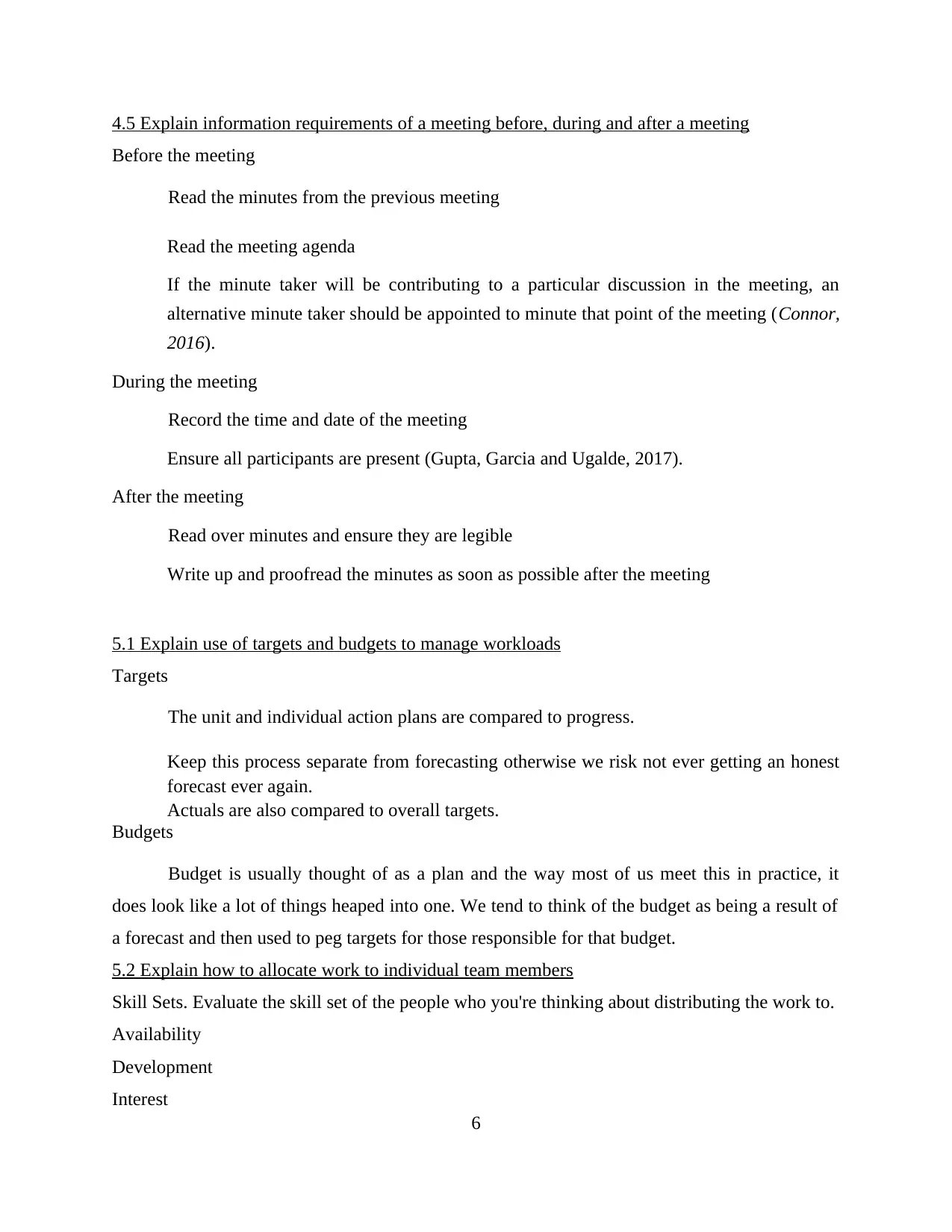
4.5 Explain information requirements of a meeting before, during and after a meeting
Before the meeting
Read the minutes from the previous meeting
Read the meeting agenda
If the minute taker will be contributing to a particular discussion in the meeting, an
alternative minute taker should be appointed to minute that point of the meeting (Connor,
2016).
During the meeting
Record the time and date of the meeting
Ensure all participants are present (Gupta, Garcia and Ugalde, 2017).
After the meeting
Read over minutes and ensure they are legible
Write up and proofread the minutes as soon as possible after the meeting
5.1 Explain use of targets and budgets to manage workloads
Targets
The unit and individual action plans are compared to progress.
Keep this process separate from forecasting otherwise we risk not ever getting an honest
forecast ever again.
Actuals are also compared to overall targets.
Budgets
Budget is usually thought of as a plan and the way most of us meet this in practice, it
does look like a lot of things heaped into one. We tend to think of the budget as being a result of
a forecast and then used to peg targets for those responsible for that budget.
5.2 Explain how to allocate work to individual team members
Skill Sets. Evaluate the skill set of the people who you're thinking about distributing the work to.
Availability
Development
Interest
6
Before the meeting
Read the minutes from the previous meeting
Read the meeting agenda
If the minute taker will be contributing to a particular discussion in the meeting, an
alternative minute taker should be appointed to minute that point of the meeting (Connor,
2016).
During the meeting
Record the time and date of the meeting
Ensure all participants are present (Gupta, Garcia and Ugalde, 2017).
After the meeting
Read over minutes and ensure they are legible
Write up and proofread the minutes as soon as possible after the meeting
5.1 Explain use of targets and budgets to manage workloads
Targets
The unit and individual action plans are compared to progress.
Keep this process separate from forecasting otherwise we risk not ever getting an honest
forecast ever again.
Actuals are also compared to overall targets.
Budgets
Budget is usually thought of as a plan and the way most of us meet this in practice, it
does look like a lot of things heaped into one. We tend to think of the budget as being a result of
a forecast and then used to peg targets for those responsible for that budget.
5.2 Explain how to allocate work to individual team members
Skill Sets. Evaluate the skill set of the people who you're thinking about distributing the work to.
Availability
Development
Interest
6
⊘ This is a preview!⊘
Do you want full access?
Subscribe today to unlock all pages.

Trusted by 1+ million students worldwide

5.3 Explain different quality management techniques to manage the performance of
administrative team
Key Performance Indicator is a measurable value that demonstrates how effectively a
company is achieving key business objectives (Hiscox, 2015).
Benchmarking- It is comparing one's business processes and performance metrics to industry
bests and best practices from other companies.
5.4 Explain techniques used to identify need for improvements in team outputs and standards
1. Pareto Analysis can be used to analyse the ideas from a brainstorming session.
2. Brainstorming- It provides a quick means for tapping the creativity of a limited number of
people for numerous ideas
6.1 Explain characteristics, requirements and purposes of different types of events
Trade Shows-
An exhibition for companies in a specific industry to showcase and demonstrate their
new products and services.
Conferences-
Together with academic or scientific journals, conferences provide an important channel
for exchange of information between researchers.
6.2 Explain types of information and information sources needed to organise an event
Caterers
They are required in event as they provide food and drink at a social event or other
gathering.
Organiser
They are required to plan an event and provides success to it.
6.3 Discuss how to plan an event
1. Develop Event Goal and Objectives. The very first step is to establish a tangible goal and
objectives
2. Organize a Team
7
administrative team
Key Performance Indicator is a measurable value that demonstrates how effectively a
company is achieving key business objectives (Hiscox, 2015).
Benchmarking- It is comparing one's business processes and performance metrics to industry
bests and best practices from other companies.
5.4 Explain techniques used to identify need for improvements in team outputs and standards
1. Pareto Analysis can be used to analyse the ideas from a brainstorming session.
2. Brainstorming- It provides a quick means for tapping the creativity of a limited number of
people for numerous ideas
6.1 Explain characteristics, requirements and purposes of different types of events
Trade Shows-
An exhibition for companies in a specific industry to showcase and demonstrate their
new products and services.
Conferences-
Together with academic or scientific journals, conferences provide an important channel
for exchange of information between researchers.
6.2 Explain types of information and information sources needed to organise an event
Caterers
They are required in event as they provide food and drink at a social event or other
gathering.
Organiser
They are required to plan an event and provides success to it.
6.3 Discuss how to plan an event
1. Develop Event Goal and Objectives. The very first step is to establish a tangible goal and
objectives
2. Organize a Team
7
Paraphrase This Document
Need a fresh take? Get an instant paraphrase of this document with our AI Paraphraser
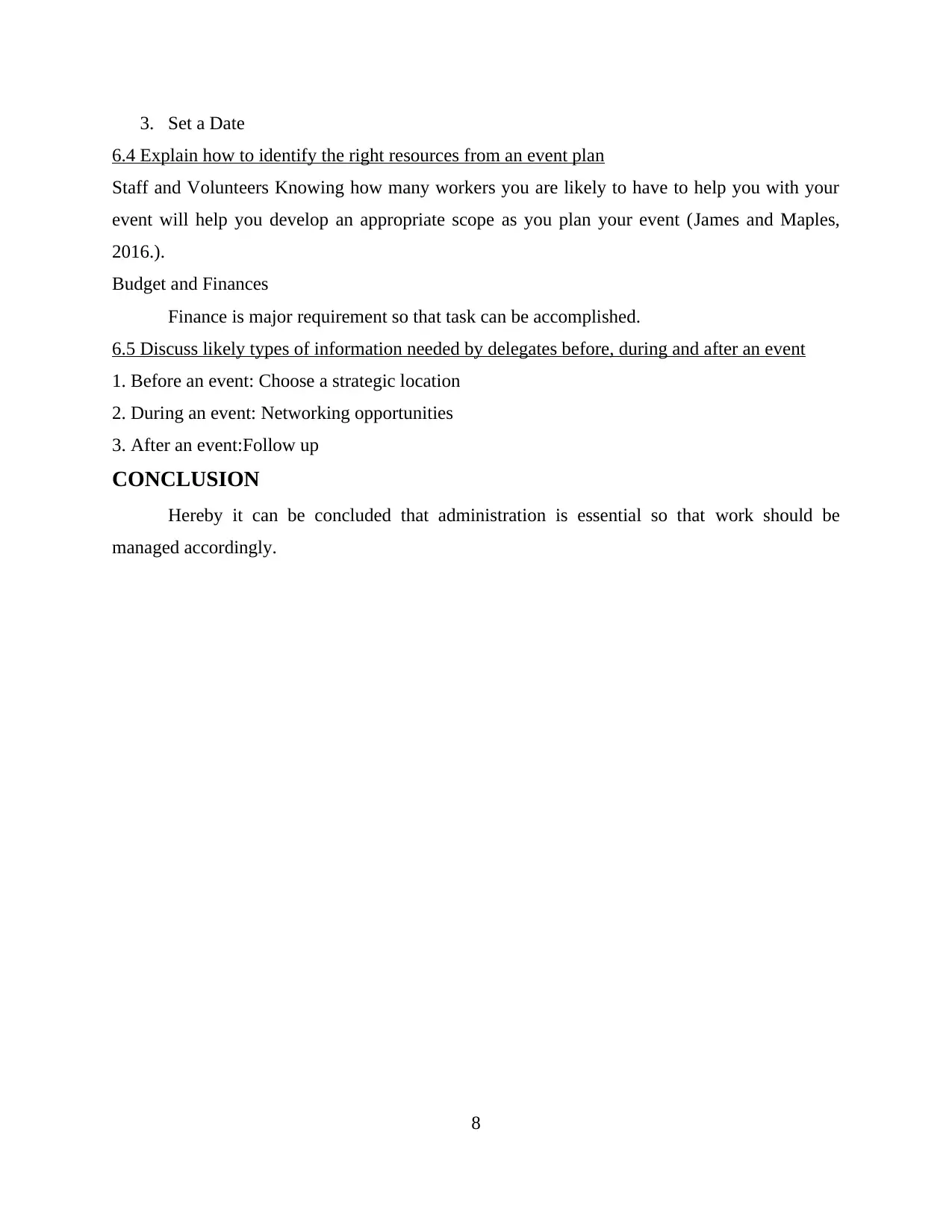
3. Set a Date
6.4 Explain how to identify the right resources from an event plan
Staff and Volunteers Knowing how many workers you are likely to have to help you with your
event will help you develop an appropriate scope as you plan your event (James and Maples,
2016.).
Budget and Finances
Finance is major requirement so that task can be accomplished.
6.5 Discuss likely types of information needed by delegates before, during and after an event
1. Before an event: Choose a strategic location
2. During an event: Networking opportunities
3. After an event:Follow up
CONCLUSION
Hereby it can be concluded that administration is essential so that work should be
managed accordingly.
8
6.4 Explain how to identify the right resources from an event plan
Staff and Volunteers Knowing how many workers you are likely to have to help you with your
event will help you develop an appropriate scope as you plan your event (James and Maples,
2016.).
Budget and Finances
Finance is major requirement so that task can be accomplished.
6.5 Discuss likely types of information needed by delegates before, during and after an event
1. Before an event: Choose a strategic location
2. During an event: Networking opportunities
3. After an event:Follow up
CONCLUSION
Hereby it can be concluded that administration is essential so that work should be
managed accordingly.
8

REFERENCES
Books and Journals
Filippatos, T. D. and Elisaf, M. S., 2016. Basic principles of fluid administration. Evidence-
based Medicine & Public Health. 2.
Gupta, A, Garcia, C. and Ugalde, M., 2017. Utilizing Lean Principles to Improve Immunization
Administration Efficiency in a Pediatric Mobile Clinic Program.Pediatric Quality &
Safety. 2(5). p.e037.
Hiscox, E. T., 2015. Principles and Practices for Baptist Churches: A Guide to the
Administration of Baptist Churches. Kregel Publications.
James, S. and Maples, A., 2016. The relationship between principles and policy in tax
administration: Lessons from the United Kingdom capital gains tax regime with
particular reference to a proposal for a capital gains tax for New Zealand. eJournal of
Tax Research. 14(2). p.455.
Juárez, F., 2014. Review of the principles of complexity in business administration and
application in financial statements. African Journal of Business Management. 8(2).
p.48.
Kline, R. B., 2015. Principles and practice of structural equation modeling. Guilford
publications.
Marume, S.B.M. and et.al, 2016. The Principles of natural justice in public administration and
administrative law.
Organ, J. F. and et.al, 2014. Public trust principles and trust administration functions in the North
American model of wildlife conservation: Contributions of human dimensions
research. Human dimensions of wildlife.19(5). pp.407-416.
Swanson, C. R., Territo, L. and Taylor, R. W., 2016. Police administration: Structures,
processes, and behavior. Prentice Hall.
Willis, N., Chavkin, N. and Leung, P., 2017. Finding “Health” and “Meaning” in Texas-Sized
Turnover: Application of Seminal Management Principles for Administration and
9
Books and Journals
Filippatos, T. D. and Elisaf, M. S., 2016. Basic principles of fluid administration. Evidence-
based Medicine & Public Health. 2.
Gupta, A, Garcia, C. and Ugalde, M., 2017. Utilizing Lean Principles to Improve Immunization
Administration Efficiency in a Pediatric Mobile Clinic Program.Pediatric Quality &
Safety. 2(5). p.e037.
Hiscox, E. T., 2015. Principles and Practices for Baptist Churches: A Guide to the
Administration of Baptist Churches. Kregel Publications.
James, S. and Maples, A., 2016. The relationship between principles and policy in tax
administration: Lessons from the United Kingdom capital gains tax regime with
particular reference to a proposal for a capital gains tax for New Zealand. eJournal of
Tax Research. 14(2). p.455.
Juárez, F., 2014. Review of the principles of complexity in business administration and
application in financial statements. African Journal of Business Management. 8(2).
p.48.
Kline, R. B., 2015. Principles and practice of structural equation modeling. Guilford
publications.
Marume, S.B.M. and et.al, 2016. The Principles of natural justice in public administration and
administrative law.
Organ, J. F. and et.al, 2014. Public trust principles and trust administration functions in the North
American model of wildlife conservation: Contributions of human dimensions
research. Human dimensions of wildlife.19(5). pp.407-416.
Swanson, C. R., Territo, L. and Taylor, R. W., 2016. Police administration: Structures,
processes, and behavior. Prentice Hall.
Willis, N., Chavkin, N. and Leung, P., 2017. Finding “Health” and “Meaning” in Texas-Sized
Turnover: Application of Seminal Management Principles for Administration and
9
⊘ This is a preview!⊘
Do you want full access?
Subscribe today to unlock all pages.

Trusted by 1+ million students worldwide
1 out of 13
Related Documents
Your All-in-One AI-Powered Toolkit for Academic Success.
+13062052269
info@desklib.com
Available 24*7 on WhatsApp / Email
![[object Object]](/_next/static/media/star-bottom.7253800d.svg)
Unlock your academic potential
Copyright © 2020–2025 A2Z Services. All Rights Reserved. Developed and managed by ZUCOL.





